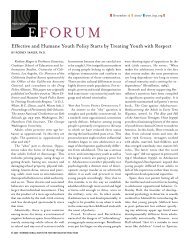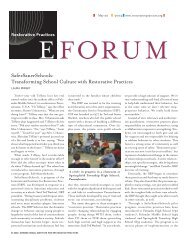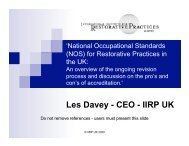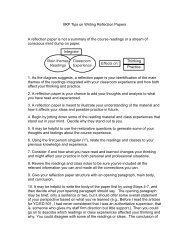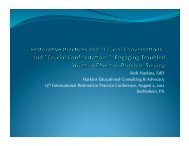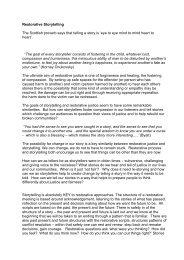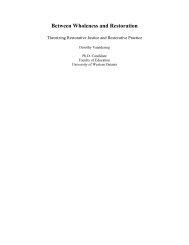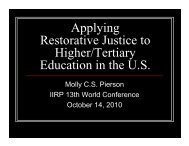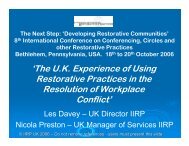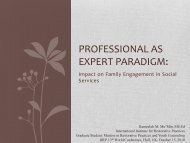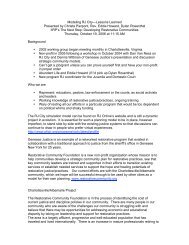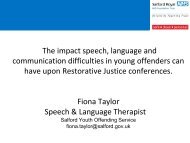Restorative Justice Practices of Native American, First Nation and ...
Restorative Justice Practices of Native American, First Nation and ...
Restorative Justice Practices of Native American, First Nation and ...
You also want an ePaper? Increase the reach of your titles
YUMPU automatically turns print PDFs into web optimized ePapers that Google loves.
<strong>Restorative</strong> <strong>Practices</strong>E FORUMinto our territory, our laws apply to you,<strong>and</strong> vice versa. Just like if somebody fromthe U.S. went to France.”Because <strong>of</strong> the Two-Row Wampum, the<strong>Justice</strong> Department <strong>of</strong> Canada recognizesrights <strong>of</strong> <strong>Native</strong> people to create theirown laws, said Thompson. The <strong>Justice</strong>Department <strong>of</strong> Canada developed theAboriginal <strong>Justice</strong> Department, whichprovided $72 million to help the <strong>First</strong><strong>Nation</strong>s create their own justice systems.“Now a lot <strong>of</strong> people are developingtheir own justice programs <strong>and</strong> thegovernment is actually saving money.The federal penitentiaries were crowdedwith <strong>Native</strong> people. Ten years ago it cost$46,000 a year to keep one inmate injail. But when we rehabilitated them itcost nothing, so they gave us money.” Thesame premise applies to probation, saidThompson. “They said, Who would bebetter to supervise these people than thepeople themselves? That’s where we gotthe money to operate our own probation,parole <strong>and</strong> police departments.”“The Indian Act was forced upon us in1898 in Canada, <strong>and</strong> it had all these rules<strong>and</strong> policies on how to conduct yourself.But we don’t force things on people. Ourcustom is to ask the people what theywant to do—to come to a communitycollective agreement.” Accordingly, in1991, the Akwesasne <strong>Justice</strong> Departmentperformed an assessment for the community,asking justice-related questions:“Who should be addressing crimes? Doyou think that the outside courts shouldbe doing this or should we be doing itinternally?” The results <strong>of</strong> the surveywere used by the department to developan administration to address problemsthemselves, including their own laws,their own mechanism to resolve conflicts,<strong>and</strong> their own enforcement <strong>and</strong>rehabilitative processes.In 1994, the department organizedthe Council <strong>of</strong> Neh-Kanikonriio. Itwas decided that whenever there was anMay 26 2004issue, a conflict or a dispute it should goto this council, “the ones who sit withthe people <strong>and</strong> come up with solutions<strong>of</strong> how to make things right <strong>and</strong> restorethe balance <strong>and</strong> harmony within the community,”said Thompson. About 30 men<strong>and</strong> women sit on the council—respectablecitizens <strong>of</strong> the community—elders,middle-aged people <strong>and</strong> a few young“The Indian Act was forcedupon us in 1898 in Canada.But we don’t force things onpeople. Our custom is to askthe people what they want todo—to come to a communitycollective agreement.”—Louise Thompsonpeople. A training seminar teachescouncil members the elements necessaryto conduct a hearing.A panel <strong>of</strong> three or four councilmembers reviews each case. The panel,the victim <strong>and</strong> <strong>of</strong>fender involved in theincident, <strong>and</strong> the resource staff—drug<strong>and</strong> alcohol counselors, child <strong>and</strong> familyservice workers or mental health workers,depending on the circumstances—meetfor a hearing <strong>and</strong> come up with an agreement.The council asks people who cometo them who else they would like to attendthe hearing. “Sometimes people ask to attend,<strong>and</strong> we ask the victims’ <strong>and</strong> <strong>of</strong>fenders’permission,” said Thompson. Thissystem has been in use since 1995, aidedby United States federal <strong>and</strong> Ontarioprovincial government funding.The first thing <strong>of</strong>fenders must do in ahearing is “give respect to Mother Earth,”said Thompson. Often people involvedin criminal activity have totally neglectedthat responsibility, she said. “We bringthese people back down to reality <strong>and</strong>back down to earth, make them realizewww.restorativepractices.orgthat life is so much more meaningful thanhaving money to buy cars <strong>and</strong> clothes.You have to believe that there’s somebodyspiritual over you.”The next step in a hearing is to acknowledgewhy the person has beenbrought before the panel, in a respectfulway, welcoming that person to theoccasion. Then everyone tells the circumstances<strong>of</strong> what happened, <strong>and</strong> eachperson is asked to recommend the bestway to restore the balance <strong>and</strong> harmonyin the situation. A facilitator—a paidjustice-program staff member who coordinatesthe hearing <strong>and</strong> organizes thecircle—takes notes; panel members preparethe document <strong>of</strong> an agreement <strong>and</strong>everybody signs it.The process used in the council isderived from traditional methods, saidThompson. “Back in the 1950s, we hadone person sitting there as justice <strong>of</strong> thepeace, <strong>and</strong> she still brought in the practices<strong>of</strong> the culture, but the manner wasstill very mirrored to the European. Itwasn’t until the 1990s when we decidedthat we didn’t have to practice what theypractice, because we are our own people.That’s the time we put our foot down<strong>and</strong> said, ‘No, we are going to adopt ourtraditional ways—getting everyone together.’”Continued Thompson, “I’m<strong>of</strong> the Wolf Clan, <strong>and</strong> if I did somethingthat would violate the principle <strong>of</strong> theGreat Law [the Kaianerekowa], my clanwould come to me <strong>and</strong> tell me to get backon the right path. It’s those principlesthat we modified to use within the Neh-Kanikonriio Council.”Thompson talked about facilitatinga hearing for “a hard-core personin leather jeans <strong>and</strong> jacket, didn’t giverespect for anybody, had a lengthy record.He was advised by his lawyer togive this a try. [His charge was] assaultwith a weapon. We thought, How are weever going to get through to this guy? Webrought him in, treated him with respect,© 2004 INTERNATIONAL INSTITUTE FOR RESTORATIVE PRACTICES 23⁄4



